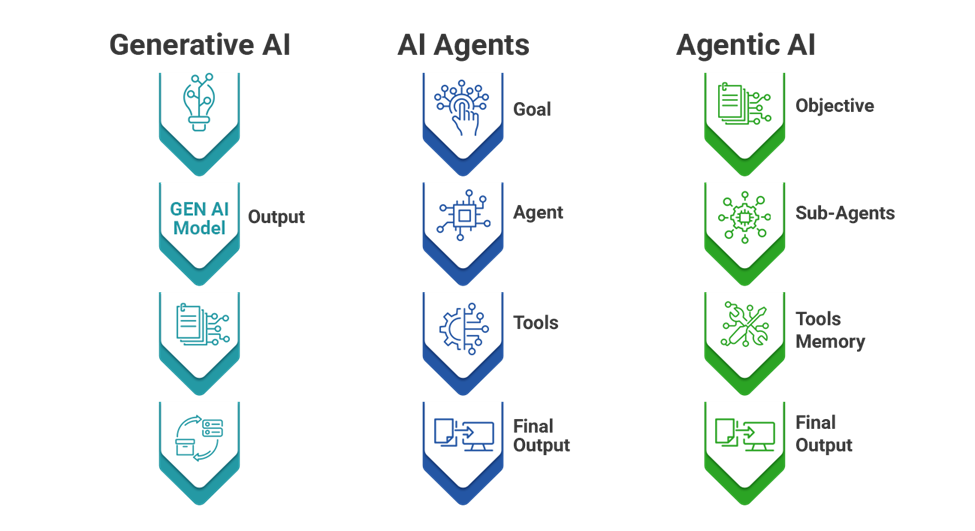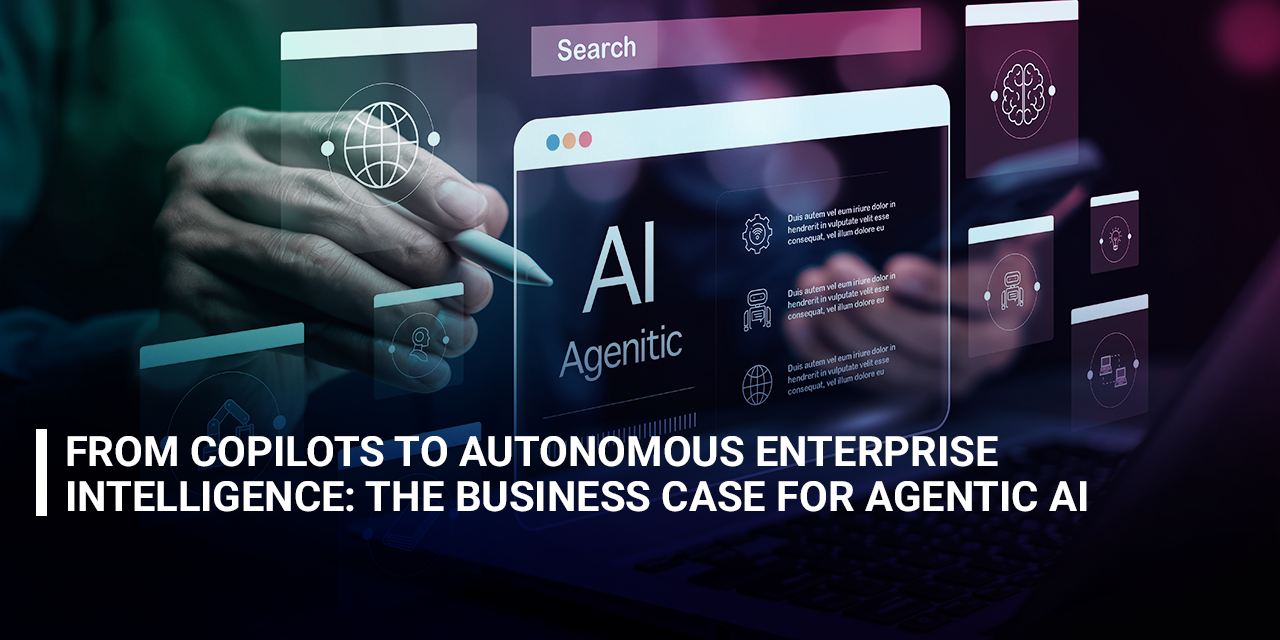Research
Share Knowledge
Brainstorm Ideas
What Agentic AI Adds: How Agents Solve the GenAI Paradox
Agentic AI isn’t about fancy tech. It solves structural bottlenecks that have so far held back GenAI’s financial viability, scalability, and widespread business adoption. However, it is essential to understand that Agentic AI, AI agents, and GenAI, while closely related, are fundamentally distinct in their design, purpose, and maturity. So, before we dive into their nitty-gritty, let us get our definitions clear.
Defining the Core Concepts
• Generative AI (GenAI): Refers to the foundational models and systems that generate diverse kinds of content (text, summaries, code, images, etc.). While they excel at generation, GenAI systems lack the ability to make or act upon decisions autonomously.
• AI Agents:
Extend beyond generation. They can perceive context, plan, decide, and execute tasks autonomously.
AI Agents = LLM/AI Model + reasoning + tools/services + memory + goals.
• Agentic AI:
Represents the broader ecosystem that manages and orchestrates one or more AI agents, coordinating their interaction with each other,
enterprise systems, and human stakeholders.
Agentic AI = AI Agents + orchestration + alignment + enterprise integration.

Whether singular or multi-agent, an agentic architecture unifies intelligent, computational, and contextual resources to harness collective intelligence, adaptability, and operational alignment of AI across the enterprise.
How Agentic AI Transforms GenAI Deployments
| Challenge in GenAI-only Deployments | What an Agentic Architecture Brings | Financial/Operational Impact of AI Agents |
|---|---|---|
| Reactive, prompt-driven outputs only | Agents can plan, decompose goals, execute workflows, monitor, and adapt | Reduces human overhead, speeds up decision cycles, and increases throughput |
| Silos & lack of system integration | Agents connect to data, tools, and systems (ERP, CRM, ticketing, supply chain) and interact autonomously | Better utilization of existing assets, avoidance of duplication, and more consistent decision-making |
| High experimentation cost; slow payback | Agents allow vertical workflows to be automated, feedback to flow, and learning to be embedded | ROI scales; cost per task falls over time |
| Diffused benefits are hard to measure | Agentic systems, through coordinated AI agents, tie outputs to business metrics such as error rates, cycle time, cost savings, and revenue impact | Easier to build a business case; clearer justification for investment |
Operationalizing GenAI for Measurable Value
Agentic AI operationalizes GenAI into delivering measurable value by embedding AI agents deep within business workflows. These AI agents leverage the reasoning and generation capabilities of GenAI, transforming it from an experimental use case or soft-benefit cost-center tool into a tangible, scalable value driver that supports high-impact functions across enterprise verticals.
The Conservative vs Progressive Debate: When and How to Adopt Agentic AI
There are two schools of thought among enterprises and consultants on how to adopt Agentic AI effectively.
View 1: Conservative / Sequential Approach
Position: Start with foundational GenAI tools (chatbots, copilots, summarization, internal bots), stabilize those, build data maturity and governance, and then consider agentic AI.
Arguments for this approach:
• Lower initial risk: Less likely to encounter complexity, compliance, integration, or security issues.
• Culture & trust building: Users gain comfort with AI tools, and executives see early wins that foster confidence.
• Better data & tech readiness: As systems, APIs, and unstructured data pipelines mature, agentic systems become more reliable and scalable.
View 2: Progressive / Leapfrog Approach
Position: Begin with agentic AI (or design for it from day one), treating agents not as a distant goal but as an integral part of the early AI architecture.
Arguments for this approach:
• Faster, bigger payoff: Moves directly into automating high-impact, vertical workflows instead of delaying business value.
• Avoid retrofitting baggage: Building infrastructure for passive GenAI only can make future integration with agents costly and complex.
• Competitive advantage: Early adopters of agentic AI can lead in automation, agility, and scalability.
A Balanced, Hybrid Strategy for Enterprises
Given the strengths and trade-offs of both views, the optimal approach for many enterprises is a hybrid or staged strategy that blends conservative stability with progressive readiness.
1. Parallel Tracks
2. Design for Agentic Compatibility Early
3. Governance, Trust & Oversight
4. Pilot & Scale Vertical Processes
5. Continuous Learning & Evolution
Track A: Deploy foundational GenAI use cases that carry minimal risk (e.g., internal knowledge bots, document summarization, copilots for sales or HR).
Track B: Design simultaneously for agentic readiness — identify high-impact vertical domains, define agentic workflows, and build prototype agents.
• Ensure data pipelines and system APIs are agent-friendly.
• Build governance, audit, and feedback mechanisms early.
• Architect modular systems: agents as components that can plug into both existing and future workflows.
• Embed human-in-loop or human-on-loop controls for agents initially.
• Define audit logs, policy engines, and escalation paths clearly.
• Address security, compliance, and risk before scaling autonomy.
• Choose 2–3 high-impact verticals (e.g., procurement, customer operations, finance/risk) for agentic pilots.
• Measure results against KPIs such as cost savings, cycle time, error rate, and satisfaction metrics.
• Establish feedback loops — agents should learn, refine, and adapt continuously.
• Track ROI, false positives, and unintended behaviors.
• Iterate or retire underperforming agents or workflows.
Key Takeaways for Leadership & Strategy Teams
• Lead with the paradox: Use data showing the mismatch between GenAI adoption and real outcome impact (e.g., “80% adoption but minimal bottom-line gain”).
• Show Agentic AI as the solution: Position agentic capabilities (planning, autonomy, integration) as the levers that resolve the GenAI value paradox.
• Demonstrate both paths: Present a strategy that starts with conservative GenAI use cases while architecting for agentic readiness.
• Stress readiness & gaps: Highlight data maturity, integration architecture, governance, and talent as prerequisites for scaling autonomy.
How ITPN Can Help
ITPN has leading-edge capabilities and top-class expertise in generative AI and agentic AI systems development. We have highly skilled & trained developers, engineers, and advisors who have what it takes to deliver excellence and help businesses attain better ROI.
Connect with us to learn more about what we offer or for any kind of assistance.

